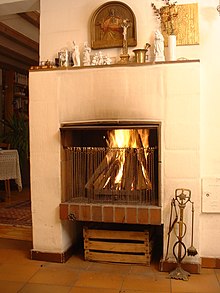Fireplace
**1. Types of Fireplaces:**
– Manufactured fireplaces made with sheet metal or glass fire boxes
– Electric fireplaces as built-in replacements for wood or gas or retrofit with log inserts or electric fireboxes
– Wall mounted electric fireplaces, electric fireplace stoves, electric mantel fireplaces, and fixed or free standing electric fireplaces
– Masonry and prefabricated fireplaces fueled by various sources
– Ventless fireplaces fueled by gel, liquid propane, bottled gas, or natural gas
**2. Fireplace Accessories:**
– Grates, fireguards, log boxes, andirons, and pellet baskets for fuel cradling and combustion acceleration
– Heavy metal firebacks for heat capture and protection
– Fenders to contain embers, soot, and ash
– Fireplace tending tools like pokers, bellows, tongs, shovels, brushes, and tool stands
– Wider accessories including log baskets, companion sets, coal buckets, and cabinet accessories
**3. History and Evolution of Fireplaces:**
– Ancient fire pits in caves or dwellings
– Raised hearths with venting through windows or roof holes
– Chimneys invention in northern Europe in the 11th or 12th century
– Count Rumford’s shallow firebox design for improved smoke ventilation
– Evolution of fireplace design through different architectural movements
**4. Heating Efficiency:**
– Blower-equipped fireplace units for efficient heat transfer via convection
– Firebacks that reflect heat back into the room
– Modern wood-burning masonry fireplaces with high efficiency ratings
– Special heavy fireboxes reaching efficiencies as high as 80%
– Masonry fireplaces with glass fire windows for efficient heating
**5. Health, Safety, and Environmental Concerns:**
– Health effects of wood combustion on respiratory health
– Risks associated with gases, ethanol fires, and indoor air quality
– Environmental impact of burning hydrocarbon fuels
– Importance of chimney filters for safety
– Household air pollution effects on health and the environment
A fireplace or hearth is a structure made of brick, stone or metal designed to contain a fire. Fireplaces are used for the relaxing ambiance they create and for heating a room. Modern fireplaces vary in heat efficiency, depending on the design.


Historically, they were used for heating a dwelling, cooking, and heating water for laundry and domestic uses. A fire is contained in a firebox or fire pit; a chimney or other flue allows exhaust gas to escape. A fireplace may have the following: a foundation, a hearth, a firebox, a mantel, a chimney crane (used in kitchen and laundry fireplaces), a grate, a lintel, a lintel bar, an overmantel, a damper, a smoke chamber, a throat, a flue, and a chimney filter or afterburner.
On the exterior, there is often a corbelled brick crown, in which the projecting courses of brick act as a drip course to keep rainwater from running down the exterior walls. A cap, hood, or shroud serves to keep rainwater out of the exterior of the chimney; rain in the chimney is a much greater problem in chimneys lined with impervious flue tiles or metal liners than with the traditional masonry chimney, which soaks up all but the most violent rain. Some chimneys have a spark arrestor incorporated into the crown or cap.
Organizations like the United States Environmental Protection Agency (EPA) and the Washington State Department of Ecology warn that, according to various studies, fireplaces can pose health risks. The EPA writes "Smoke may smell good, but it's not good for you."
